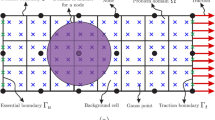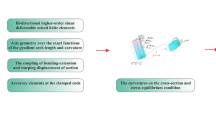Abstract.
Many analysis models utilize finite elements of reduced dimension. However, to capture stress concentrations at local details, it would be desirable to combine the reduced dimensional element types with higher dimensional elements in a single finite element model. It is therefore important in such cases to integrate into the analyses some scheme for coupling the element types that conforms to the governing equations of the problem. In this paper, a novel method that can correctly couple beams to solids, beams to shells and shells to solids for elastic problems is presented. The approach adopted is to equate the work done on either side of the interface between dimensions, and this leads to multi-point constraint equations, thus providing a relationship among nodal degrees of freedom between the differing element types. Example results show that the proposed technique does not introduce any spurious stresses at the dimensional interfaces.
Similar content being viewed by others
Author information
Authors and Affiliations
Additional information
ID="A1" Correspondence and offprint requests to: C. G. Armstrong, School of Mechanical and Manufacturing Engineering, The Queen's University of Belfast, Ashby Building, Stranmillis Road, Belfast BT9 5AH, Northern Ireland. E-mail: c.armstrong@qub.ac.uk
Rights and permissions
About this article
Cite this article
Shim, K., Monaghan, D. & Armstrong, C. Mixed Dimensional Coupling in Finite Element Stress Analysis. Eng Comput 18, 241–252 (2002). https://doi.org/10.1007/s003660200021
Issue Date:
DOI: https://doi.org/10.1007/s003660200021




